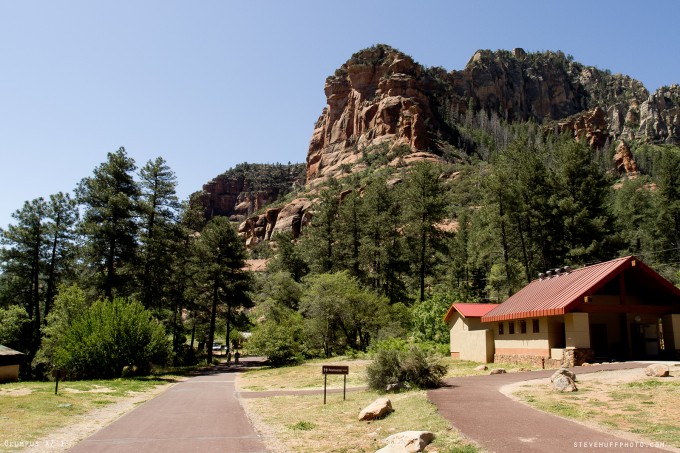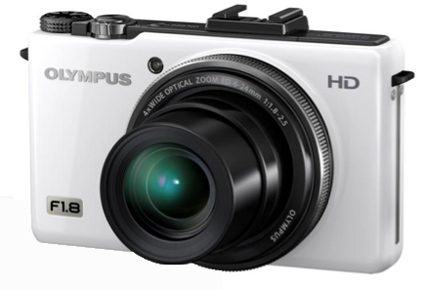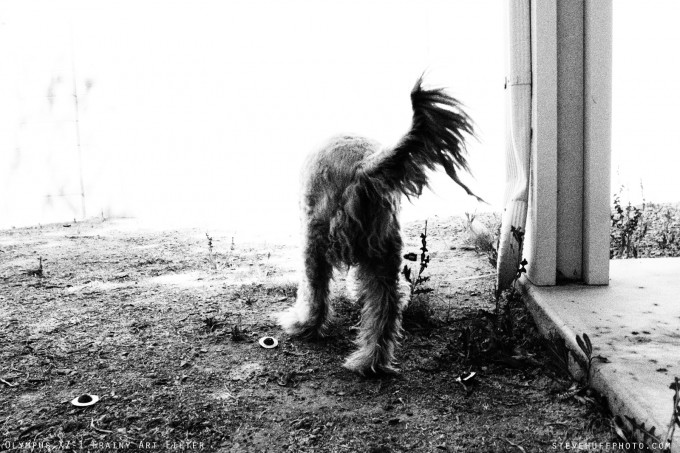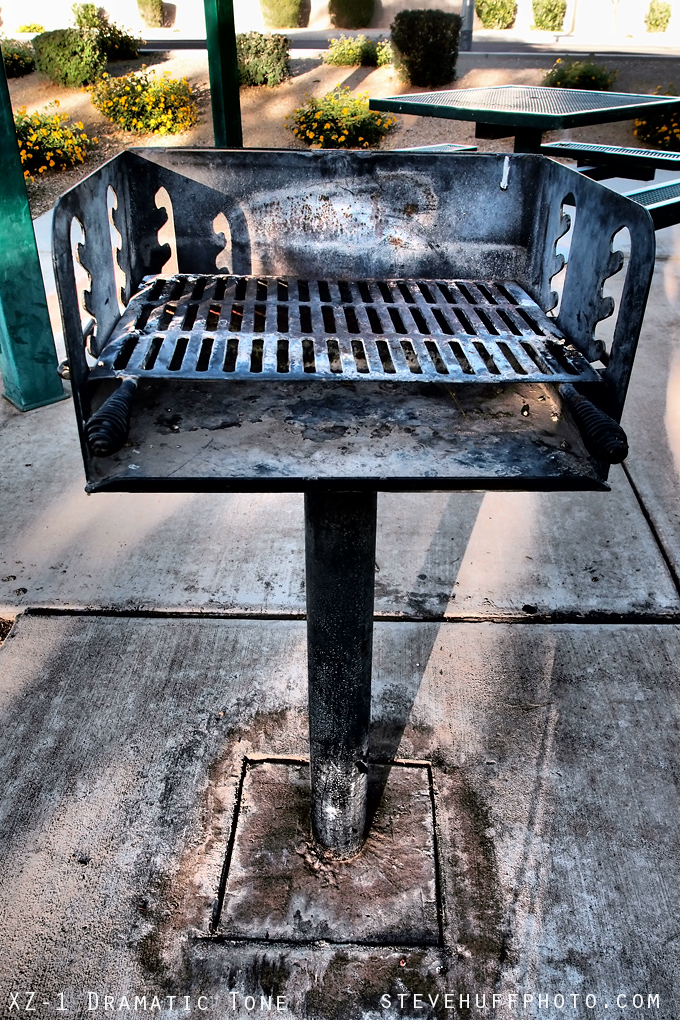
The Olympus XZ-1 Digital Camera Review
By Steve Huff
Ah yes, the Olympus XZ-1. I was supposed to have this review up last week but with all of the Fuji X100 and Leica X1 hoopla I had to push this one back because I did not have the time to go over the images I snapped with the camera until now. I have been toting along this little powerhouse of a compact for a couple of weeks now and I have to say that I am pretty impressed with the cameras capabilities. I will keep this review short and sweet, and it will focus on my real world use of the camera and NOT charts and resolution tests.
It will also be a VERY short review as there is no need to go on and on about the camera because it just does what it does, and it does it well.
Olympus released the XZ-1 with a mission in mind. That mission was to release a small compact camera that would not only have more features, better quality and a larger sensor than others in its class, it appears they also wanted to take on some of the super compacts like the Leica X1 and new Fuji X100. While I do not feel the XZ-1 is a replacement for something like an X100, it can at times give similar results if you are printing small or shooting for web display.
Yes, in many ways, this camera can almost approach the quality of the Fuji X100 and Leica X1, and it is a smaller sensor compact! Of course, in other ways, like noise, dynamic range, and total IQ, it is not up there with the super-compacts but it is an option over the cameras that are in the XZ-1’s class, and dare I say, a better one? Maybe, maybe not. It all depends on what you are looking for in a compact-ish camera.
The fact is that 90% of us really do not NEED more camera than this! Most of you reading this are most likely hobbyists who shoot and post to the web. Others may have found this page through google while searching for their 1st high quality compact digital. If that is the case, the XZ-1 is one of the best compacts I have had the pleasure to shoot with (in the smaller sensor compacts) if not THE BEST. It is also a camera that is super easy to take with you anywhere. It fits easily into the front pocket of my cargo shorts.
The Red Rocks of Sedona, in Black & White! XZ-1 at f2.5 and ISO 100 – Noise in sky is from the B&W conversion.
First off, I know there are other cameras in this class that I already really enjoy. Which ones? The Leica D-Lux 5 and Panasonic LX-5 are at the top of my compact list along with the little Ricoh GRDIII (GRD review HERE). Those are cameras I really loved and raved about right here on this site. The D-Lux 5 was my top choice for a high quality compact camera but this may have just changed with the XZ-1 just because it does so much right, and so little wrong.
What makes this little Olympus special though is its all star cast of features. This little guy has everything you can imagine or wish for in a compact camera, even a little bit larger of a sensor for even better performance over the other small cameras.
Here are the official specs of the XZ-1
10 Megapixels
The 10 million pixels in the high-resolution CCD create superior image quality. Create poster-sized prints without losing a single detail.
Large, High-Sensitivity CCD
Providing the best image quality ever in a compact Olympus camera, the large 1/1.63-inch CCD enables greater dynamic range and smoother gradations from highlights to shadows.
4X iZuiko Zoom Lens
Based on the standards of Olympus DSLR lenses, the wide aperture of the iZuiko f1.8-2.5 allows a rich and vibrant range of photographic expression. It allows faster shutter speeds in low light – and it allows for a shallower depth of field than most compact point-and-shoot cameras.
HD Movie 720p
A simple, one-touch button allows you to record movies with amazing clarity in high-definition, right from your camera.
Accessory Port
The XZ-1 includes a port for accessories including the SEMA-1 Microphone adapter set and the VF-2 live-finder, a detachable electronic viewfinder. The viewfinder easily slides onto the camera’s accessory port and hot shoe to provide 1.15x magnification for a 100% field of view. The VF-2 rotates up 90 degrees which is useful when shooting subjects from challenging angles. The external accessory port also allows for connection with the SEMA-1 external microphone adapter set for enhanced audio capture.
In-Camera Art Filters-Movie and Still Images
With six in-camera Art Filters (Pop Art, Soft Focus, Grainy Film, Pin Hole, Diorama and Dramatic Tone) you can explore your artistic side while taking both still shots and HD video. The Art Filters can be applied as you shoot, no additional software required.
New Easy-to-Use Live Guide Control
Seeing the results before you shoot can change the way you take a picture. Want more vivid or muted color in your shot? Want warmer or cooler hues? Want a brighter or darker subject, or a sharper or softer background? Or maybe you want to capture the fast-moving action of your subject with a little artistic blur, or perhaps freeze the action? Simply set the camera to iAuto, press OK to engage Live Guide, then press the up and down arrows on the back of the E-PL1 to easily slide through numerous photographic effects. Make adjustments and watch the LCD as the effects are made live — before the image is captured! Live Guide also features a Tips section on how to compose a shot or shoot kids, pets, flowers and more.
Dual Image Stabilization
Dual Image Stabilization combines Sensor-Shift Image Stabilization with high ISO sensitivity and fast shutter speeds so you can capture crisp, clear images even if the subject is moving.
In-Camera Panorama
Captures three images and stitches them together to create one amazing panoramic picture by simply pressing the shutter button and slowly panning across a panoramic scene.
AF Live View With AF Tracking
F Live View works as seamlessly as a point-and-shoot to display subjects, in focus, on the LCD the instant the shutter is pressed half way. AF Tracking locks your subject into focus right on the LCD, and constantly adjusts focus and brightness whether you or your subject is moving. With this mode, a simple push of the AF button and shutter release enables you to keep fast-moving and unpredictable subjects in focus.
Advanced Face Detection
Face Detection automatically focuses on your subjects’ faces and optimizes exposure for sharp, brilliant portrait pictures.
TruePic V Image Processor
In addition to more detail, the image sensor, combined with the next-generation TruePic V Image Processor, delivers excellent dynamic range, accurate color fidelity and reduced noise, all the way up to 3200 ISO.
–
The XZ-1 at f/4 and only 1/50s. I must have had the ND filter on as this was a bright and harsh sunny day in AZ. Beautiful Oak Creek Canyon always provides for some nice landscapes. The XZ-1 did well here, and honestly, just about as good as the X1 and X100 did in this same scene. Hmmmm, that slightly larger image sensor seems to do the trick.
–
My quick and short review. What I like about this camera and my conclusion on the XZ-1 vs other compacts.
I decided to keep this review short and to the point as there are tons of other reviews out there already on the XZ-1, and loads of users who rave on and on about this camera. I’m a bit late to the game so I will basically just let you know my final conclusion, and what I like and dislike about the camera. More importantly, if I were in the market for a new compact-ish camera, would I choose the XZ-1 over the competition? If so, why?
The things I like about this little guy is that it is sleek, thin and built pretty well. It can take the Olympus EVF (one of the best EVF’s to date) and the front dial on the lens controls your settings like Aperture, ISO, etc (ala Canon S95, which this camera does indeed beat for IQ).
The XZ-1 records 720P HD video and has built in image stabilization so you wont get the shakiness in your footage, AND YES, it works pretty good. There are two macro settings, macro and SUPER macro so you can get super close to your subject. The ART filters from the PEN series are here as well, even the new DRAMATIC TONE filter. My personal fave, the grainy B&W filter is also here which is just as good on the XZ-1 as it is in the PEN series.
The lens opens up to a fast f 1.8 and the camera has a built in ND filter just like the Fuji X100. This way, if you want to shoot at 1.8 in the sun, just flick on the ND and go for it!
The Auto Focus is pretty fast and accurate as well.
It has all of the formats such as 4:3, 3:2, 16:9 and 1:1 for those square format junkies. Olympus seemed to want to be king of the compacts with this one, but os there anything I did not like?
YES.
I do not like that Olympus does not supply you with a dedicated battery charger. You have to plug the camera itself in to the outlet to charge the battery.
Also, the camera has no real grip. Sometimes it felt a little uncomfortable to hold while shooting when compared to other offerings.
Sometimes the images seemed a bit soft (at higher ISO) and the in camera noise reduction is a but too aggressive for my tastes. Sometimes the images can appear mushy when shooting higher ISO. I am not 100% convinced that the image quality beats the Leica D-Lux 5 but Olympus also gives you all the cool stuff that you do not get in the D-Lux. The art filters, 1.8 lens, control dial behind the lens barrel, ND filter, etc.
I also had an issue with the camera remembering my settings. I would set the center focus point when shooting but when the camera was turned off, and on again, it would “forget” that I had set it to center point only. Kind of irritating but not a deal breaker.
Finally, some are saying that they feel the XZ-1 is too large. Not quite a compact, and not quite a larger sensor camera. The fact is that the XZ-1 is thin, sleek, and somewhat tall. BUT it fits in my pocket no problem. I like the design and style personally.
I would say that the XZ-1 is a jack of all trades and master of most. It takes great video too, equal to the D-Lux 5 video quality.
In fact, the XZ-1 may be the most feature packed little compact camera EVER, and it is available in black or white for those that care about style as well as function. If you want a do it all easy to use camera that you can take with you anywhere, the XZ-1 may be the one you are looking for. If you do not want to mess with changing lenses and just want that ONE small camera that can do just about everything for you, this is the one folks.
Looking pretty snazzy in white!
IMO, the quality and joy of use you get from it makes it an easy recommend. It was tough to take a bad shot with this camera, wether I was messing with the art filters or shooting in Aperture priority mode. It does come in at $499 though and at that price you are awfully close to the E-PL2 kit which sells for $599. If you do not care to go up in size, I would recommend the E-PL2 over the XZ-1 for its larger sensor and overall better Image Quality and responsiveness. You would lose the macro and super macro modes though. Always a give and take. One thing to keep in mind is that when shooting with smaller sensor cameras you will get more image noise in general and it will be tougher to blur out backgrounds for subject isolation. This is another area where something like an E-Pl2 would do better. Larger sensor usually means less noise, more DOF control. But with cameras like the XZ-1 it is the size that matters, and many of us just want SMALL with big performance. The XZ-1 DOES indeed deliver on this.
–
SO, which compact is the best bet?
Overall, if i were in the market TODAY for a compact-ish camera that delivered the goods, it would be between this XZ-1 and the D-Lux 5/LX-5. Personally, I am not a fan of the Canon S90 or S95. Sure they are small, but when I tried out the S95 I thought it was a bit over rated and I hated the feel and build. Everyone has their own tastes though, so the key is to buy a camera that YOU like with features you want. All I can say is, the XZ-1 is the new king of compacts. It was hard to NOT like this one as it just did so much right.
The lens is good, but I am not 100% if it can beat out the lens on the D-Lux 5/LX-5. It seems softer to me, but that doesn’t stop this camera from producing great results. I applaud Olympus for releasing it! It could possibly be the compact of the year just as I think the Fuji X100 will be “Camera of the Year for 2011”.
With all of that said, I will leave you with the images I managed to snap while I had the camera. I did not shoot that many as I was always shooting the X100 over the past two weeks!
As always, click on any one of them for a larger and better version.
If you want to buy the XZ-1, I highly recommend B&H photo, which is where this one came from. Many of you know that B&H is my main camera shop of choice and I have never had one bad experience with them in over 15+ years. Their Olympus XZ-1 page is here, and if you follow my link here to buy one, I will get a teeny credit that helps support and keep this website chugging along, so thank you!
Using the Dramatic Art Filter, you can see it adds “Drama” to the scene 🙂
The Macro mode works well, as does the “Super Macro” mode. Up close, out of camera JPEG…
And you know me, I loved the grainy B&W filter on the PEN series, and I am happy to see Olympus add it to their compact XZ-1.
More Drama...
–
The Pinhole Art filter adds a vignette around the photo.
The color of the XZ-1 is really good. Typical Olympus style. Also, you can get some shallow DOF effects if you shoot up close and have the lens wide open.
[ad#Adsense Blog Sq Embed Image]
I NEED YOUR HELP! YOU CAN HELP SUPPORT THIS SITE TO KEEP IT GOING AND GROWING!
Remember, anytime you follow my links here and buy from B&H or AMAZON, this helps to keep my site going. If it was not for these links, there would be no way to fund this site, so I thank you in advance if you visit these links. I thank you more if you make a purchase! I have nifty search bars at the upper right of each page so you easily search for something at either store! I currently spend 10-14 hours a day working on this site and the only way that I can pay for it is with your help, so thank you! Currently my traffic has been increasing but my funds to pay for the site has been decreasing, so any help would be GREATLY appreciated!
Even if you buy baby food, napkins or toothpicks at amazon it helps this site, and you do not pay anything extra by using the links here. Again, you pay nothing extra by using my links, it is just a way to help support this site, so again, I thank you in advance ![]()
If you enjoyed this article/review, feel free to leave a comment at the bottom of this page and also be sure to join me on twitter or my new facebook fan page! Also, you can subscribe to my feed at my subscribe page HERE and read these posts in your browser or news reader! Also, the new forums are NOW OPEN on this site so get involved if you like! Thanks so much for visiting my site!

















Nice pix!
I ordered the camera this afternoon…happy to see how great they look
Hey Steve,
What would you recommend are the best settings for street photography with this camera? Just picked this up from amazon and haven’t been too pleased with my current setup. Thanks!
I bought the xz-1 sometime ago, but just saw your review of it. I have to admit that for me it is an ideal little camera. I got around the lack of grip on it by putting a little “flipbac” grip on it. works great!
When I’m out for a little serious photography I carry my Olympus E-PL3 with a Panasonic 20mm f1.7 pancake lens. This allows me to frame just about what I am seeing and the results are very good. I can carry the xz-1 in my pocket and the e-pl3 around my neck and if I need a different focal distance the xz-1 will do a good job for me.. I have the VF-3 viewfinder that I carry in my pocket and it works with either camera. I use it in bright conditions that make the monitor hard to read. I also love the ND filter on the xz-1. I’m sure there are better cameras for people who demand the very best, but for the average enthusiast like me the Olympus pair are fine for me. I never carry the flash for the e-pl3, because it seldom needs one, but if I do need a flash I have the pop up on the xz-1.
How would you compare this to the new FUJI X10 ?
Great review, Steve – I’ve had this camera for a few months now and what I would have written is pretty much word for word what you have done.
Always look forward to your wise words.
Andrew
I have as yet to try the XZ-1 in RAW, but other than that it is quite in a class of itself, but I do agree about the grip: could have been better – it can easily slip. I love using it with my wife’s EVF-2 viewfinder (she often prefers her K-5 to her E-PL1). When I haven’t got acces to the viewfinder I usually attach a Hoodman loupe to the display! Almost as good ;-)!
If I am not packing my Pentax(es) & lenses I bring my XZ-1, and the Sony DSC-HX9V, which in bright light has a few more tricks up its sleeve (like sweep panorama), and has a much longer zoom. As long as the sun shines I’d say the Sony is slightly better, but in medium and low light there is no competition – the XZ-1 rules!
In RAW this is an outstanding camera, I convert using Olympus Viewer 2 and turn off the Noise Filter.
Up through ISO 400 the results are superb and one finds out just how incredibly sharp this lens is!
This or Ricoh GR Digital III? Which did you prefer using Steve? For hands on enjoyment and ergonomics.
Hi Steve,
I wonder do you have write a review for Lumix LX-5 before? I searched but couldn’t find any in your site. thx
Really enjoyed the review, but am I the only one that consistently gets mostly TOO much in the way of pink skin tones out of the XZ-1? In 95% of the pictures I have taken of Caucasian people..skin is WAY too pink/magenta-ish. So much so even in raw I can’t really get skin tones right. As to in camera noise reduction..I see it in xz-1 pictures taken even in bright sunshine..at ALL isos. just kicks in even more at higher iso. The lens is great..with almost no distortion or chromatic aberration. However the unrealistic skin tones the xz-1 produces plus the totally smeared jpegs has me wondering should I sell mine? I have an x100 which I LOVE, but still want something a tad smaller/ lighter to carry around in my pocket,for moistly outdoor shots. I’ve owned the S90, TL-500, and still own the LX5…Gave my LX5 to my wife as it’s such a great camera, I sold my TL-500 but it MAY have been the best out of the bunch in some respects, looking back.
If you are just shooting scenery and using RAW, I do think the XZ-1 is about the best small camera out there in this class, but for people shots, and is you want to use jpegs..I think one can do better…
If you use raw, then use Adobe Camera Raw since the Oly software of course will render the same colours – pleasant but not entirely accurate.
However, I recommend to get an alternative camera profile for the XZ1 (can be found in the dpreview forum discussions).
The IQ and the lens is great, when using ACR colors are neutral and resolution is outstanding.
Took some test shots in the camera store onto my sd card and took a look at home. Such a good camera but ultimately let down by it’s smudgy, aggressive noise reduction which you can’t turn off.
I think I am going with the GRD3. For a bloke that shoots film, likes the cameras small and simple and with great operation – all roads seem to lead to the Ricoh.
i have tested the olympus xz-1 , Panasonic Lx5 and the Canon Powershot s95 and i found the Canon Powershot s95 to have the sharpest IQ.
so for me the s95 is the best and has the most accurate colour Qaulity.
Bought the XZ1 and returned it within 48 hours. Nice specs but the usability just wasn’t there. Biggest beef for me was the auto ISO function. The camera will not choose an ISO higher than 200 90% of the time no matter how little light there is. As steady as I’d like to think my hands are, I can’t hold the camera steady for 1/2 second. There is no direct ISO button. So it’s quite a chore to have to access ISO changes via menus all the time. Only direct control for ISO is if one uses the P mode, and the lens barrel ring becomes ISO control. But I generally use aperture priority in all my cameras.
Totally with Steve on the aggressive noise reduction. Things look good in JPG up to ISO 400. Then all of a sudden, it just goes downhill quickly and images are very soft. IMO, the Canon S90 provides better IQ. Too bad I can’t stick the XZ1’s lens on the S90.
Agree on the Auto ISO, but I just changed to using S-mode instead in low light situations. It’s a compact, aperture doesn’t really make *that* much difference, especially seeing in low light you are going to be at 1.8-2.5 anyway, which it what it uses. Auto ISO works really well in S-mode.
Steve, are you going to review Samsung EX-1? That’s the last of serious compacts you didn’t test.
I really enjoyed looking at the pics.
I have owned nearly all the high end compacts and the XZ-1 is the keeper because of the optional EVF. It puts this camera in a totally different class. I hate holding cameras away from my face – it’s the worst shooting position. The IQ is as good as the LX5 (until now the class leader) and the lens opens wider. The EVF just puts it out ahead of the rest.
You can also use the EVF on the LX5 and D-Lux 5….
The quality of the EVF on the XZ1 is far superior. I have tried the Panasonic EVF and was disappointed.
What I mean to state is that the whole sensor/film size linear relation to DOF control has been very over simplified, adopted and believed without understanding or testing and become a bit of a old wives tale. I too jumped on the bandwagon in the past without doing (or understanding) the science.
No need to solve differential equations to calculate DOF. Look at the picture of the young lady at f1.8. Do you think the bokeh is better than a Panasonic GF1 with 20mm lens? I don’t.
Other more technical reviews state that the actual circle of confusion is larger on this relative to sensor size and BETTER DOF control exists over pretty much all of the M43 options unless they had a 0.95 lens on it.
The sample shots that I have seem certainly bear this out. Even on my Canon A480 I get great DOF control when used at long end of zoom and macro mode on.
It is not quite correct to say that sensor or film size effects DOF. I was corrected on this myself a while back by some pretty serious photogs that explained the truth of the matter in the same breath as the Scheimpflug principle…..
You will get greater DOF control than other compact cameras in the same class though, with the same size sensor and slower lenses (LX5, S95, G12, P7000). And though the Samsung EX1 lens is as fast, it’s 40mm shorter on the long end (72 vs 112mm).
The ‘elephant in the room’ most seem to miss is the zuiko lens. 2.5 at the long end and super sharp wide open. This is pretty unique.
Thanks for the review! I don’t think this camera would suit me, but I like the see the direction things are going.
Steve, nice review, thank you. There’s a great add-on grip from Richard Franiec that works really well and adds no bulk or weight to the camera. The JPEGs can be soft/mushy at times (aggressive noise reduction), but the RAWs are stellar, and quite malleable.
I don’t understand how olympus price their products. At the moment you can get an oly E-PL1 for $50 less (or E-PL2 for $70 more) with a better sensor & interchangeable lens. Compared to similar products, I prefer a Canon G12 (at same price) because of excellent controls/dials. What makes this camera stand out compared to competition? I don’t think it’s the size…
I think Olympus is about to release a replacement for the EP2 and possibly the EPL2 so that may explain to some degree the pricing. The reason I’m interested is the lens isn’t interchangeable but it is also f1.8. If you look at M 4/3 you only right now have the Panasonic 20 that comparable as far as aperture is concerned. But that’s just me. Plus I have a unshakeable attraction to non Canon/Nikon cameras. 🙂 I currently use a Pentax, Fuji, Olympus, and Sigma (DP’s). And yes, I’m sure a GXR is in my future. So I’m just probably not the person to comment on marketing strategy or to get camera advice from. 🙂
It’s the lens.
It is fast for sure…but I haven’t seen reasonable bokeh even from m4/3 sensors, let alone point & shoot sensors. Regarding low light photography with a fast lens, I find it doable but challenging with APS-C DSLRs using fast primes (without flash of course). Again, not that useful on a small sensor.
One other point: do you think if this camera is designed for general P&S demographic or enthusiasts? Point&shooters don’t care about a fast lens, and enthusiasts expect way more for $500 (considering options available).
I own an XZ-1, so I guess the target market is me. I weighed up the options, and the XZ-1 ticked the most boxes that I needed, while having compromises that I could live with (and hope they fix for some, but be able to live with even if they don’t).
To my eye/needs, IQ is equal to LX5 & G12/S95, lens is faster at the long end (which I found quite limiting on the S90, particularly at concerts and indoors shooting), RAW/continuous performance is better than G12/S95, bit more reach than the LX5, and I like the Oly colors more than the Panasonic ones (subjective, obviously). It’s also bloody quiet with the sound turned off.
Aside from some minor quibbles, and a poor movie mode, I’m really happy with it. In terms of size it’s basically at my personal threshold of how big a camera I will take with me without thought. I’m not a photographer though, I’m just a guy who likes to take some pictures.
Fair enough. Sometimes little improvements compared to the competition stack up and make a superior product. I personally believe the only way to judge a camera is to take pictures with it for a couple of weeks. If you enjoy taking pictures with it, you’ve found your dream camera, and that’s the only thing that matters.
The other thing is … 🙂
I like that if I end up getting the EVF or accessories I can use them on an E-Px too if I upgrade in that direction in the future (unless they change the port specs again…).
Sorry one more question. If you were printing from this camera would you feel comfortable at 12 x 16?
Thanks again!!
SB
Steve,
Thanks for your reviews. The whole wall chart thing really never seems to help me decide.
Thanks to you I now have an X100, K5, and EPL2. I love all three of them, but I must admit I don’t think I’ve ever loved a camera as much as the X100. In fact I love it almost as much as my dogs Stanley and Hugo and that’s saying a lot!!!!
Anyway, I’ve been debating the XZ-1 for a couple of days. I already have the VF2 + Mal 1 weird macro lights with my EPL2. The reason I am thinking of the XZ-1 is a really like the art filters and the square format. Here’s my question, when you say a “softer” are you referring to JPEGS?
Thanks for your help, I’m just a hobby photographer. I take my dogs hiking twice a day and always have a camera with me so I’d like to take the X100 and ZX 1.
A big selling point in favor of XZ-1 is the underwater case for it that Olympus has made available at a relatively modest price. That case also seems to be better than the Canon Underwater case for the S95. Even if you don’t snorkel or scuba-dive, reliable hermetic sealing opens up new photographic possibilities if you just simply swim a bit or even just walk about in a downpour. What say?
agreed !!! … though the Canon case is quite a bit cheeper … cheers
The underwater case is excellent, as it transforms the XZ-1 to a one-hand camera, with no risk it will slip out of you hand. Provides excellent weather protection (thus not just water), and weighs just a little.
Access to all controls is very easy (much easier than with the camera itself), except the +/- EV correction. It can be activayed, but as you have no way of operating the thumb wheel you’re stuck!
Actually, since the XZ-1 lens is f/2.5 at the long end vs the f/5.6 of kit zooms for M43, you can get similar DOF for portraits. Surprised me, too, but it was shown in a German photo mag.
Good point.
Thanks. Incidentally, I picked the S95 after months of agonizing. In the end, I realised that – for me – the single deciding factor was size.
Steve, I have been reading reviews after reviews of the XZ1 and also loving your review. I think its just a sexy cam. But I have the EP2 and the X100 and the voigtlander 25mm 0.95 Nokton and I am saying to myself, why do I need another XZ1?
I like the idea of using the EVF on the XZ1, which will make it into a powerhouse, but that solution is not as elegant as the Fuji x100 built in EVF/OVF. Thats THE ONE TO BEAT. I use my right eye and the Fuji’s finder is on the left…Purrfect.
The XZ1 is just not much smaller than the Fuji x100 or the EP2 with my tiny c mount 25mm f1.4 lens. So it isnt going to win me over in that department as well. I think Olympus, being the master of minituarization (OM1, XA series, Pen D, etc etc) could have easily made this much more compact, almost discreet, hide in one palm type. I think there is a strong strong market for something that portable and powerful.
But if I didnt have the Ep2 or the Fuji, and if I wasnt interested in Bokeh and shallow DOF type pics, then the XZ1 would probably be a fantastic choice. It would produce stunning sharp pictures as you mentioned.
My wish Olympus if you are listening, make us an Olympus XA, make it small, powerful (aperture priority), give it a small screen behind I dont care. I would sacrifice compactness and pro features then a large screen behind. But have the EVF built in on the top left of the rear. This model will not compete with the EP series and EP users will find a place for such a cam.
I do not need an XZ-1 either. I see it for those who are buying their 1st camera or someone who just wants a small take anywhere. It is quite a bit smaller than the X100 though.
Hey Steve,
Nice sweet / short review. I looked at both the Lumix LX5 and the XZ-1 and did a bunch of side by side shooting. I felt the Oly images were a little flatter, but ultimately had more info in the files. The LX5 looked nice and crisp, but seemed to block up some in the shadows.
I also liked that there was a reasonably priced underwater housing to throw the Olympus in, rather than needing an Ikelite housing for the Lumix.
Keep the reviews coming, and can’t wait to see you in Seattle.
See you soon!
As always a very nice review.
I was looking at the new XZ-1, but got the Canon s95 instead because it is smaller and I think the image quality is about the same. The sensor of the s95 is 1/7″ (7.6mm x 5.7mm) while the Olympus has a slightly larger sensor of 1/6″ (8mm x 6mm)
There is no doubt that the Olympus is a very fine camera, but so is the s95, which I think has great build quality and very good usability. For me it is also a joy to use.
I just picked up an XZ-1 in white with the EVF-2. I needed something to bring along on surf trips and professional shoots for documentation of setup or scouting. the XZ-1 is Larger than my previous Canon S90. BUT…, the size matters in this case. Holding my S90 felt like I was going to drop it, and probably introduced a lot of camera shake in my shots with the S90. BTW, and this is a big BTW, the Canon S90/S95 cameras do fail frequently in the lens build department. Mine failed to pull focus at only 10 months, Canon claims it was either due to leaving it inside my car or taking it to the ocean, Really, Canon??? For a 10MP I’m impressed with my XZ-1 so far, the IS is far better than the S90, the lens quality is what I remember from earlier Olympus clamshell XAs in a way. So far, this camera tops my images from my Canon S90 which never really impressed me, even though I edit everything in RAW. I recommend the XZ-1 for the same reasons as this review, the large control ring is far more useful than Canon’s also. I’m not trying to rag on Canon, I just think people tend to over-rate Canon’s IQ and build/design too often in reviews and don’t put them through the same hoops that some shooters do, and of course, I am disappointed with Canon since my S90 failed so quickly and there response was to blame everything on me.
Yours was S90, mine was Canon 1Ds. It died one morning quietly without any apparent reason, in the middle of an assignment in a remote area in Kenya, that too within first 6 months. It was bought brand new for about $8000, the MOST professional Canon at that time. Canon customer service was equally ‘nice’ with and told me it was my fault. Of course that was the last Canon I ever bought.
Nice review, Steve. For me, the D-Lux 5 will stay in my bag. Whats exciting s larger sensors in smaller form factors! Good days ahead , thanks to companies like Olympus.